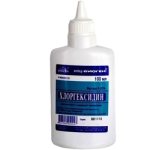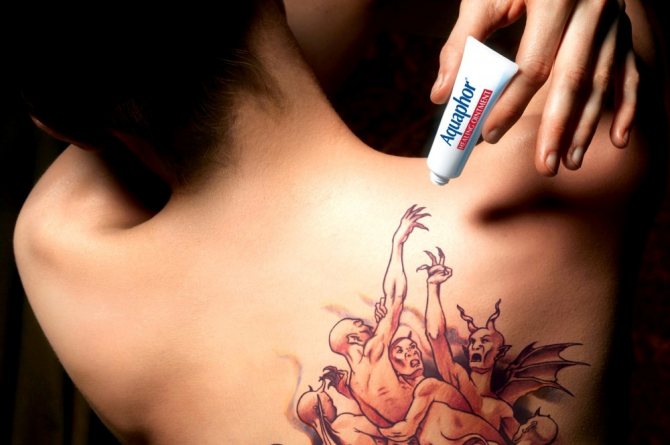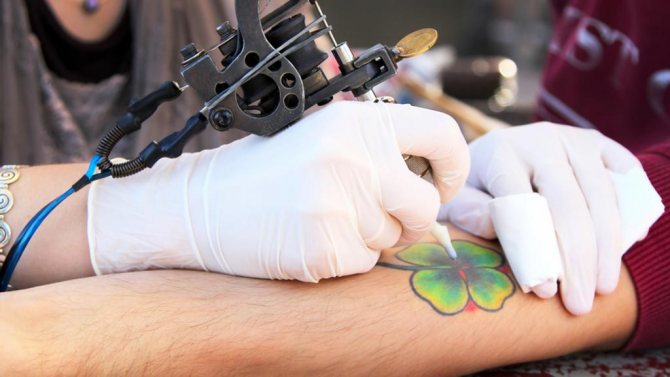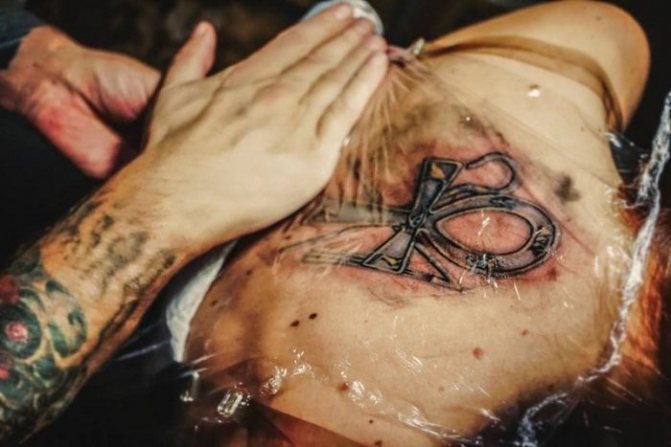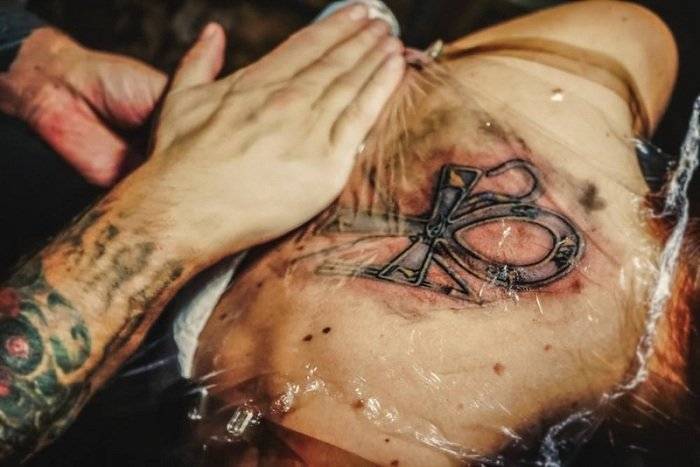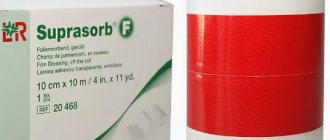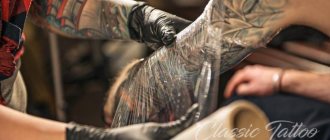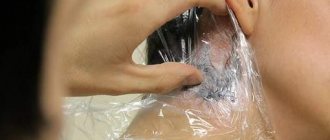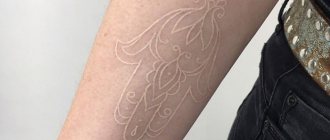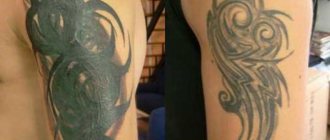Most people who got a tattoo for the first time, for a long time did not dare to take such a serious step. And now a freshly chiseled tattoo is adorned on your body, you want to see what happened sooner. But there is no hurry! From your actions the first days after the application depends on its further beauty.
Let while the tattoo remains under a layer of gauze or bandage, which the master closed the tattoo. The place of the drawing should remain sterile, the gauze or bandage also contributes to fast healing. Protection in the form of polyethylene film preserves sterility, but slows down the natural healing processes. It is recommended to remove the plastic wrap as soon as you are at home.
It is very important, when caring for a new tattoo, to protect it from external factors while the skin is healing. Make sure nothing rubs the skin! If the place where the tattoo is applied is in contact with clothes (the tattoo in the waist area is in contact with the belt of jeans or pants, on the wrist with the cuffs of jackets), then you should choose more loose clothing (for example, a loose cut dress, and a jacket with three-quarter sleeves).
Cleanliness.
Don't take any chances; the risk of infection is already high. Be sure to WASH your hands before you remove the bandage, and always before you touch your tattoo. Wash your tattoo gently. To do this:
- A warm solution of soap should be used.
- Do not use a towel!
- Do not use a large basin or tub, and do not put the tattoo under the tap.
- Moisture should be removed with a soft cloth or paper towel.
- DO NOT RUB! Gently blot the tattoo area.
- Apply a thin layer of antibacterial ointment. The ointment will protect the tattoo from infection and moisturize the skin, you can apply the ointment several times. The color of the tattoo depends on how moisturized the skin was the first days of application. The less flaky, the brighter the color!
- Do not use peroxide or alcohol, as they are very drying to the skin.
Thus, follow to wash the tattoo several times a day for a week.
You should temporarily give up showers, swimming pools and hot baths. Tap water contains many bacteria, which can lead to infection, and the chlorine used for disinfection can discolor the drawing you just painted.
Avoid sunlight on your tattoo, it may fade. Especially do not sunbathe on the beach or in a tanning bed. As a last resort, the tattoo should be covered with something. Remember, the appearance of the tattoo for many years depends on the first care!
How to remove skin itching and inflammation
A tattoo artist will recommend an ointment to treat the wound. Bepanten, D-panthenol, Dexopanthenol, Solcoseryl, Traumel C are good for regeneration.
If the tattoo itches after healing, it is worth clarifying in the salon paint composition and contact a dermatologist.
Treatment
Depending on the complexity of the situation, the doctor will prescribe a course of therapy:
- antihistamines (Suprastin, Psilo-balm, Tavegil, Fenistil-gel);
- antibiotics;
- anti-inflammatory agents (Chlorhexidine).

If any doubts remain and the dermatologist cannot determine exactly why the tattoo itches, most likely he will refer you to an allergist for tests and samples.
Treatment of eczema takes a long time and does not always completely eliminate the disease. The main problem is that the red flaky spots cover not only the tattoo area, but also spread to other areas of the body, causing physical and mental discomfort.
The therapy is carried out in a variety of ways, including:
- hormonal, antibacterial, antihistamine ointments;
- sedatives, up to and including tranquilizers;
- vitamin complexes;
- immunomodulators.
In addition, it is necessary to observe the diet, making a diet of porridge, dairy products, vegetable soups and salads. Completely abandon smoked meats, pickles, alcohol, coffee, and corn.
Recommendations for the rehabilitation period
Even before the beginning of the session, the master should explain what to do after the end, to avoid unpleasant consequences.
- It is necessary to keep the skin clean, treat the wound.
- Alcohol should be excluded completely for at least 2 weeks.
- The bandage should be removed after 4-6 hours to allow access to oxygen, apply protection before going outdoors.
- You should not remove the crusts that have formed. This will affect the healing of the skin and the preservation of the pattern.
- Do not take a steam bath, swim in a pool or open water, or sunbathe.
The tattoo session should be carried out only after the exclusion of contraindications - it is diabetes, skin diseases, pregnancy, poor blood clotting. If the master warns that, for certain reasons, the healed tattoo may bother you later, it is better to refuse the procedure.
Source: VseProZud.ru
Emissions
It is quite normal that for the first few days there is a discharge on the surface of the tattoo. Tattooing, i.e. repeatedly puncturing the skin and getting paint under it, severely damages the skin. After which the healing process begins, part of it is the discharge of blood and other fluids on the surface of the skin.
It is also possible for ink to be excreted from the tattoo, which is also normal. To avoid stains on your favorite beacons or blouses, you should not wear them at first. When the skin recovers and the discharge stops, you can safely wear your favorite things.
Itchy Healed Tattoo: Causes and Solutions
But what to do if a tattoo that has already healed itches? There may be several reasons for this. The most common is infection and skin irritation. Also in this way can manifest itself as an allergic reaction. If the tattoo itches, and redness or pimples appeared, the surest decision is to visit a dermatologist and allergist. In not all cases, your tattoo artist may know the reasons for the itching if the tattoo has already healed. Sometimes a healed tattoo itches after exposure to ultraviolet light. The fact is that the paint contains certain metal chemical compounds that can interact with sunlight. As a rule, black, blue and violet colors are perceived by the body much easier than other bright colors. It is worth noting that you will need much more reverent care for tattoos made with red and orange paint, because the components in its composition are much more actively interact with ultraviolet. That's why it is recommended, turning out on a bright sun, always to use a cream with high SPF-protection. Thanks to this you can not only avoid unpleasant feelings, but also to prolong the brightness and durability of the image. With prolonged exposure to the sun, the outline begins to fade, and the colors become duller. It is unlikely that lovers of tanning and tattooing will be able to combine both of these hobbies - one will definitely have to give up.
Moisturizing and peeling
The use of antibacterial ointments can be stopped after 3-4 days. At this time it is recommended to use lotions, but be careful, the lotion should not contain shock absorbers and dyes. It is better to consult with your master, but do not forget to check the composition, perhaps on certain ingredients you have an individual intolerance. Today there are many means for the care of tattoo, but be careful to check the composition and consult a specialist.
Lotion should be applied to tattoo skin after washing to keep it soft and supple. Maximum moisturized skin will flake less, which is very important for color retention. Also, be sure to wash your hands before contact with the tattoo!
If the tattoo starts to itch, lotion should be applied to reduce the itching. The main thing is NOT to scratch!
How to check if you are allergic
As far as we know, there is no reliable way.
You can do an allergy application test. A day or two before the session, you have to go to the master and ask him for the paint that he is going to do the tattoo with. After that, take a three-layer piece of gauze measuring 1*1 cm, wet it with paint and glue it to your forearm. After a day or two, the gauze should be removed and the skin inspected. If you notice itching, redness or swelling, the test is positive, you are allergic.
Unfortunately, this test will not show one hundred percent result. Firstly, it is not medically standardized. Secondly, the concentration of dye may not be enough to cause a reaction.
One more thing: if you are going to use several colors, this procedure will have to be done with each tube. The tests can take a month, and the result will still be useless.
There are also other "folk" ways. For example, to make a scratch and apply paint to it or make a machine tattoo dot, that is a tiny real tattoo. But we don't have any proven evidence that these methods work.
Risk of infection
Tattooing used to be accompanied by a high risk of infection. Now tattoos are done in specialized salons, where all precautions are taken. First of all the skin is treated to be sterile clean before the application. It is important that a new needle is used for tattooing, not a "disinfected" one. As a rule, professionals care about their reputation and follow these rules.
The most dangerous period, during which the risk of infection is very high, is the first period after the tattoo. To reduce the risks will help to comply with the recommendations given above. But still, the main signs of infection are:
- Inflammation of the place where the tattoo is applied.
- Reddening of the skin.
- Swelling of the tattoo area.
- Pain when touching the tattoo.
Slightly painful sensations are considered normal, however if they do not decrease, but rather increase, go to the doctor immediately. Infection is very dangerous, such a serious matter should not be taken lightly.
First signs and symptoms
External signs of a tattoo allergy may appear instantly during the tattooing procedure or after a certain period of time. An allergy to a colored tattoo can manifest itself even months after application. This is usually due to the sensitivity of some pigments to temperature changes. When the temperature rises to +28oC some substances in the composition of paints can change their structure and cause an allergic reaction.
Characteristic symptoms of allergies:
- Swelling of the skin;
- severe itching;
- severe hyperemia;
- Allergic rash in the form of urticaria, with the formation of blisters, papules, nodules.
Over time, the elements of the rash can break open, forming in their place a scab. Focal inflammation in the absence of medical care become a gateway for the entry of infection.
More severe manifestations of allergies can be:
- oropharyngeal edema;
- difficulty breathing;
- angioedema.
Not only can a local reaction develop to a tattoo, but also:
- allergic runny nose;
- watery eyes;
- A tear in the eyes;
- Cough of an allergic nature.
Bottom line
Remember!!!
- WASH your hands before touching any tattoo in order to prevent infection.
- Do not be afraid of natural secretions from the tattoo area.
- It is necessary to wash the tattoo several times a day!
- Apply lotion! The skin should be moisturized to avoid flaking!
- Forget about a pool, a beach, a solarium at least for some weeks!
Follow the recommendations of your tattooist, if you went to a professional he is experienced enough and will be able to give sensible advice. It is necessary to follow the rules of hygiene, your health depends on it, and of course the beauty of the tattoo. The tattoo requires a little effort from you in the first time, but then it will bring only joy.
Surely you've spent more than one day choosing a particular drawing, or creating a sketch. Now the cherished image is painted on your body. Proper care will keep it in its place for a long time.
Get rid of dangerous papillomas FOREVER
A simple and proven way to get rid of papillomas and warts without dangerous consequences. Find out how >>.
If you recently got a tattoo on your body, and in its place the skin began to peel and peel off, do not worry - in most cases it is completely normal. We will tell you in detail why the skin on the tattoo peels, what not to do and how to alleviate the situation to avoid unpleasant consequences.
Touching
People have a strange habit - to seek to touch what interested them. You need to watch out not only for yourself, but also for the people around you. A fresh tattoo is like an open wound. And there can be a lot of bacteria on your hands that have no place on your tattoo at all. Limit your touches until the area is completely healed (at least 1-2 weeks).
Also, don't forget about our smaller brothers. It is doubtful that they will be attracted to a brightly colored design that they want to lick or touch. But it can happen absolutely by accident! It is not necessary to specify that on paws of animals dirt much more than on hands of people? In addition, it is also undesirable to get hairs on a fresh tattoo.
How to understand, whether the tattoo is healing normally or not
The skin around the tattoo usually flakes off about a week after it is applied. Visually, it may appear as if ink is coming to the surface - this is common. Excess pigment comes out of the skin, and dead epidermal particles begin to separate. Thus, when people have skin sloughing off a tattoo with ink, it's not a cause for concern. The main thing is to fight the urge to scratch or peel off crusts.
Even if the skin on the tattoo is actively peeling, continue to gently wash the area and moisturize. Any excess will come off on its own, and the shaved hair will sprout and add to the unpleasant itching and even irritation. You can relieve the bothersome symptoms by gently patting the flaky area.
Why allergies appear
Allergies are an immune error. Because of this error, the immune system perceives the substance as a danger.
It's all due to the notorious "peculiarities of the body. We are all different: some people are not bothered by allergies, while others are terrified of allergens and get itchy when a cat enters the room.
Another reaction can occur because of poor-quality paint. Suppose you have had a tattoo done in "artisanal" conditions, and the wizard used homemade or cheap pigment, which contained mercury.
Skin irritation can be caused by any chemical substance, but it has nothing to do with allergies. Nevertheless, to avoid trouble, make sure you know which paints are used by the master or the salon. Reliability and product reviews can be checked online.
How to take care of the skin after a tattoo
When the tattoo makes the skin peel and tear a lot, you can alleviate the situation with antibacterial ointments. They are used for the first few days, and then switched to lotions, but without dyes and fragrances. Good remedies against peeling of the skin on the tattoo should tell you a master.
If the skin on the tattoo is already peeling, try to avoid direct sunlight on the area. If you go to the beach, apply a quality sunscreen on your body.
As for lotions, they should be applied after washing. Qualitatively moisturized skin will not peel as much. When flaky tattoo skin and moisturizers don't help, and pus or other strange secretions appear on the surface, an infection has probably been brought in. Consult a doctor who will prescribe a suitable remedy (Bacitracin is the most common).
Anyone who has used a tattoo artist at least once has noticed that the tattoo peels off as it heals. Many (especially beginners) are worried about this and often ask the master, "Is this normal?" First of all, calm down. Yes, it really is normal. From this article, you will learn what to do when a tattoo starts peeling, and why it happens in the first place.
If you're a man, you'll understand the analogy to growing a beard. At first, the hair on the chin looks patchy and liquid, in addition, everything is terribly itchy. Over time, however, the beard grows back, becomes soft, and the itching disappears. It's the same with your tattoo that's peeling and bothersome: Just get through a period of discomfort by helping yourself with special products.
Even if your skin peels off with the paint and your tattoo looks so unaesthetic that you're afraid to look at it yourself, that's a good sign. This phenomenon is part of the natural healing process.
What makes tattoos itch - Causes of itching
Immediately after you get a new tattoo, the skin in that area becomes an open wound.
After the first 6-7 days, the tattoo will heal, shed old skin and grow new skin - it's normal for the place to itch.
Itchy tattoos can happen due to various factors - the most common ones are:
* Tender skin is the most common cause of itching. During the healing process, such skin most often itches a lot and the itching does not go away for a long time.
* Shaved hair growth - any surface where tattoos are applied is pre-shaved. During the healing process, new hair also grows back. They cause itching on the skin.
* Allergic reaction - the skin reaction to tattoo ink is the same for everyone, most often it is expressed in a slight itching, runs rather quietly and does not need medical examination. Is it okay to scratch a tattoo?
Actually... NO! Under no circumstances should you be allowed to scratch a fresh tattoo!
The worst thing you can do to your new tattoo is to scratch it. If you do do this, all the healed areas will tear off and the tattoo will be ruined. This is at best. At worst, an infection will be introduced.
Here you are, the happy owner of a new tattoo! You constantly want to look at it and boast to others. But in the euphoria of acquiring such an "accessory" many forget that tattoos require special care. Like a piece in an antique dealer's collection, body art will only look as good as new if you take good care of it.
Learn the 7 things that can ruin your tattoo so you don't get depressed about the design you've ruined.
When peeling begins
So when does a tattoo start to peel? It depends on the individual. Some begin to peel in a few days after a visit to the tattoo salon, for some - in a week. This is only determined by genes.
If you know that the new tattoo will inevitably peel off, you'll take this natural healing phase easier. However, don't go to extremes and spend all your time examining your tattoo, waiting for the epidermis to peel off. All in good time, rely on your body and find yourself something interesting to do.
The tattoo will peel off in about a week. Areas like wrists and elbows, for example, take longer to peel off, while softer parts of the body take less time. A healed tattoo may begin to peel off again. However, it doesn't look as catastrophic the second time around and goes much faster.
Don't put pressure on the tattoo!
Not everyone takes into account that the place of a fresh tattoo will need to be protected even while you sleep. When it comes to the drawing on the chest - there won't be much of a problem. But if you now have a large tattoo on your back, you will have to sleep on your stomach. As a last resort, lay a clean, thin towel under yourself. That way, if you accidentally roll over, at least you won't get something extra in your tattoo.
If you wake up and realize that your clothes or bedding are stuck to your tattoo, there's no need to try to tear the fabric away from your body. Just wet the spot with warm water, and it will easily come off on its own.
Why the skin peels off
The skin is a huge and very important organ that is constantly renewing itself. Every day we lose thousands of epidermal cells without noticing it. However, a fresh tattoo that begins to peel off allows us to see this process firsthand. To better understand how natural (and forced) skin renewal occurs, it is advisable to study its structure (see photo).
Even if the flakes of dead skin are not just white, but colored, this does not mean that the tattoo will fade, losing most of the ink used. The ink is too deep and will not be able to peel off with the epidermal cells. Flaking will not damage your image in any way.
What does itching have to do with?
To answer the question of why a tattoo itches, we will have to understand the causes and mechanism of the itching itself. This process is the removal of a keratinized layer of skin. The body itself signals us to get rid of dead cells, as it takes longer to reject them on its own and is not particularly effective. A fresh tattoo itches, which indicates an active process of skin healing, when damaged cells of the upper layer of epithelium are replaced with new ones. However, we should not forget that you should not always follow reflexes. If you start scratching the tattoo in the first days of healing, you can rip off the crust that has appeared on the skin, thereby not only bringing infection into the wound, but also getting the opportunity to earn unsightly scars.
